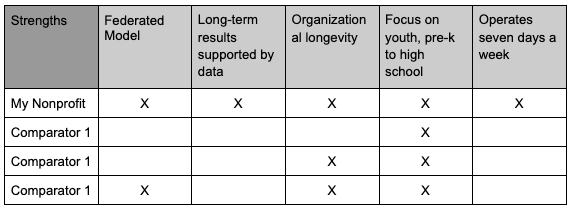The idea of competition is fraught in the nonprofit sector — after all, to solve big societal challenges, it takes multi-faceted solutions and the many organizations that provide them. So what does the competition look like? Do nonprofits even have competitors? Should they? And who are your nonprofit’s competitors?
There are more than 10 million nonprofits and non-governmental organizations worldwide, and more than 1.5 million registered with the IRS in the United States. From 2006 to 2016, the number of nonprofit organizations registered with the IRS rose from 1.48 million to 1.54 million, an increase of 4.5 percent. The fact is, many of these organizations do similar work and should collaborate or merge, but instead, they find themselves competing for the same resources.
Nonprofits aren’t just competing with one another for money and share of voice, either. They also compete with the exploding social enterprise sector, businesses with strong social and environmental initiatives, and individual fundraising efforts that take place through sites like GoFundMe, Facebook and TikTok. Organizations are challenged by increasing competition for talent as well. Some studies estimate that turnover rates could be as high as 35 percent in the sector by the end of this year, and with a strong labor market, keeping top talent is harder than ever. If these reasons aren’t enough to motivate you to understand your nonprofit’s competitors (or as we often prefer to call them, your comparators), the fact that it also helps you clarify your mission impact might be.
Understanding your nonprofit’s competition clarifies your impact
While it’s important to understand your nonprofit’s ecosystem and how you fit in, it’s also critical to understand the specific impact your organization is positioned to make. This is your secret sauce: the thing that no other organization in your immediate comparative set of similar organizations can achieve in quite the same way. At Prosper, we call this your Reason for Being. Knowing it will also help your nonprofit:
- Identify what makes you unique to donors and funders
- Better tell your brand story
- Attract talent who are most interested in your work
Let’s address how you identify your Reason for Being.
Identify your own nonprofit’s strengths
To hone your Reason for Being, and further understand your ecosystem, start by assessing your nonprofit’s strengths, or the things you think are particularly unique to your organization. While you might have a list of things in mind, it’s important to gain insights from other stakeholders, including those you serve, community leaders, members of the media, donors, funders and board members. Create a shortlist of four or five things you think make up the DNA of your nonprofit. For example, these could include things like:
- Our federated model – national reach, local impact
- Long-term results supported by data
- Organizational longevity
- Our focus on youth, pre-K to 12th grade
- Operates 7 days a week
Together, these attributes should make up something undeniably unique that your organization can claim as its own.
Determine your nonprofit’s competitors (or comparators)
If you don’t like to think of organizations in your ecosystem as your nonprofit’s competitors, you can think of them as comparators. When determining organizations in your comparative set, make a list of five to seven nonprofits based on one or more of the following:
- Organizations that provide similar services to similar stakeholders.
- Organizations with a similar model. Like the example above, if you operate under a federated model, you may want to review organizations that operate similarly, even if they provide slightly different services to slightly different stakeholders.
- Organizations with a similar geographic focus or footprint. You’ll want to identify other similar organizations in your area or areas where you would like to serve.
- Organizations you know attract similar funders and donors.
Compare
Then, take the list of strengths you came up with above and review each one of your comparator organizations to determine the similarities or differences between your strengths. See the example in the following chart.

Based on this matrix, it’s easy to see that this example nonprofit is the only one within its competitive set that operates under a federated structure, seven days a week to achieve long-term results that are supported by data.
You can only glean this type of information when you know your ecosystem and your nonprofit’s competitors/comparators. Once you do, you can also start to lean into these differences when you vet strategic decisions, think about brand communications, the nonprofit’s case for support to donors and funders and even when thinking about who the right hires might be.
What if We Don’t Have a Reason for Being?
If you can’t identify a strong Reason for Being, it might be a sign that you need to consider merging, or at least informally joining forces, with another organization. While it’s amazing to see so many organizations come to life every year that are focused on making the world a better place, we have to wonder how much more could be accomplished if more organizations joined hands, formed networks and worked together toward common goals? Yes, there might be a strong case for your organization to exist as a standalone entity, and developing your Reason for Being will help you confirm it. But if you take a hard look at your comparative set and are honest with yourself, it’s just as likely that you’re missing opportunities to merge or collaborate, and minimizing your potential for impact as a result.